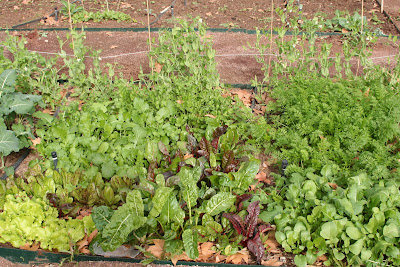For quite a few years now I have been fascinated by the effects rocks have on plants. This might seem weird but rocks have major influences on soils which in turn influence plants. Why you might ask? Well it all has to do with rock texture. Which probably leads you to another questions, what the heck is rock texture? If you look closely at many rocks you can see particles, or crystals, that make up the larger rock. Granite is a good example of a rock with obvious smaller crystals.
 |
| This is a close up of a granite counter top and clearly displays the different crystals present in the overall larger rock. The entire image is granite rock, which is made up of black, white, and gray colored crystals. The white crystals are quartz, the gray are feldspar, and the black are mica. These crystals break off, or weather off, of the original rock to form sand for soil. |
These smaller crystals with time break off of the original rock to form particles that will turn into soil. Water, chemicals, heat, cold, and so on all work together to weather, or break down, larger rocks into smaller crystals. These larger rocks are known as parent materials and are most often in the form of bedrock or mountains. Almost all of any given soil is made up of tiny weathered (or broken down) pieces of rock parent material. So crystals or particles making up rocks are eventually broken down into soil. The texture of any given rock corresponds to the texture of a soil. For example, granite has a course texture and weathers into a course texture, or sandy, soil. Other rocks such as basalt have a very fine texture and will weather into a very fine textured, or clay, soil.
 |
| Basalt has very tiny crystals that when weathered produce clay soils. The crystals in basalt are so small they typically can not be seen. |
So rock texture determines soil texture, so what? Soil texture then determines how much water a particular soil can hold. Clay soils hold lots of water for a long time but absorb water very slowly. While sandy soils absorb a lot of water very quickly but also dry out very fast. Plants will colonize and grow best in the soils with textures that hold the right amount of water for them.
So how can you identify the soil parent material and what soil texture comes from it?
1. Find the most common type of rock at a particular location.
2. Looking closely at the rock, does it have larger or smaller crystals or particle sizes?
3. The larger the crystals/particles the more sandy the soil. The smaller the crystals the more clay the soil will have.
The above rules generally hold true near mountains or where bedrock is close to the surface. It does not hold true in a few cases.
1. If the predominate rock is limestone. Limestone doesn't weather into soil particles, it rather is dissolved by water and washed away. For this reason, limestone doesn't make soil texture like other rocks but certain types of soil will form from it.
2. If you are very close to a stream or river. If you find lots of roundish rocks in the area, they are alluvial, or water, deposited. In this case the soil will typically have a lot of clay.
 |
| If you find a lot of rocks in an area that look roundish like this you can know the area has alluvial, or water deposited, soil. |
|
3. Areas with hardly any rocks are often wind or glacial soils. Glacial soils will generally have a few very round rocks and occasionally very large round rocks. These will also form special soil types but you can't use the rocks to identify the soil texture. The Midwest is covered with these types of soils.
So using rocks can be very useful when trying to understand a habitat and determining how soil is influencing plants and animals. In doing this the best book I have found in identifying rocks and their textures is "
Smithsonian Handbooks: Rocks and Minerals". This book has the clearest, most useful pictures of any rock and mineral book I have looked at. It also has extremely useful information organized in a very easy to use and understand way. One of my favorite features along with the great photos is the "grain size" information that goes along with each rock. Grain size is the rock texture that we discussed above and fine grain size will result in fine clay soils, medium grain size a silt soil (half way between sand and clay), and a course grain size a sandy soil.
While this post discussed how to identify soils by looking at rocks I will have another post on how to identify soils directly by touch and later show how these things relate to the plant and animal life in a habitat. Understanding and using rocks and soil textures are extremely useful when trying to find specific plants and even animals. I personally have used rocks to help locate plants as well as places to find birds and animals. But it works best for plants.




















